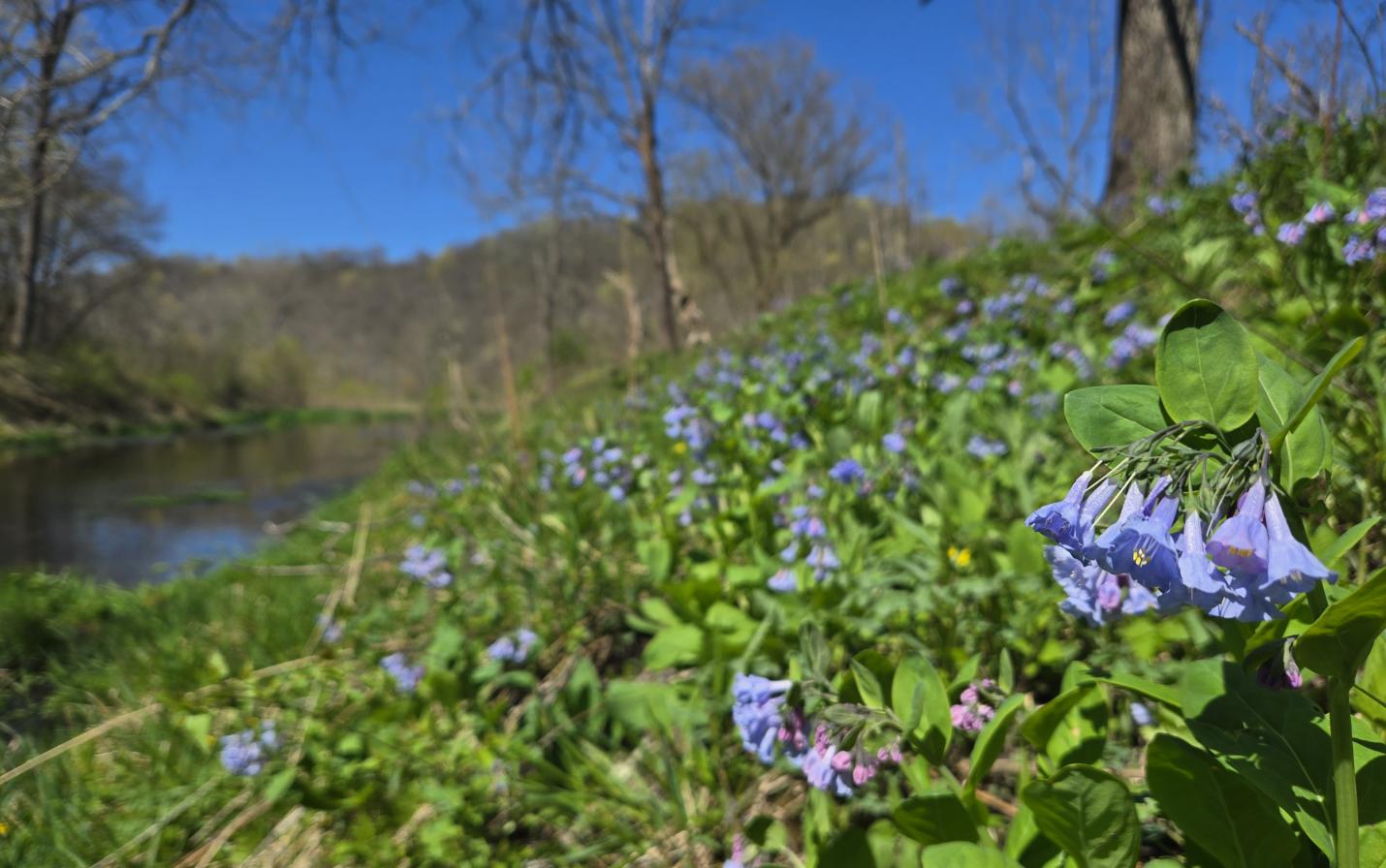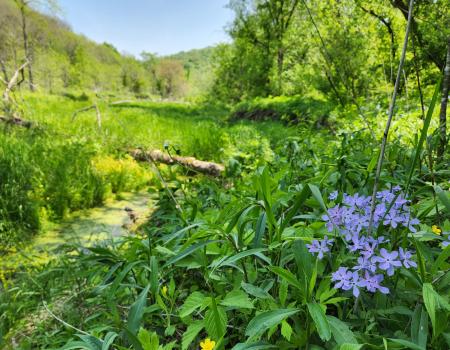
How a group of landowners worked with their local land trust to permanently protect watershed habitats
LA CROSSE, WI – There are places in the Driftless Area where life seemingly moves a little slower: days seem longer, the sounds of nature seem louder, the stars seem brighter, and sleep seems deeper. Along the banks of Tainter Creek, in Vernon County, one of these places exists, and thanks to the conservation leadership of three couples, it is now permanently conserved. Tom Seals and Ruth Wene, Grear and Linda Kimmel, and John Jones and Joan Volkmann signed 85 acres of scenic, wild land into a conservation easement with Mississippi Valley Conservancy on May 24, 2024. The conservation easement forever protects the property’s beautiful wooded blufflands, stunning floodplain, which is seasonally adorned with dazzling spring ephemeral wildflowers, and over 1,500 feet along both banks of Tainter Creek, a renowned class I trout stream.
It all started in 1994, when Tom Seals was asked if he would like to own land in Wisconsin. To Tom, the answer was easy: “I thought about owning land in Wisconsin every time I drove through there.” Tom and Ruth, along with Grear and Linda, and two other couples, looked at several properties before coming across a beautiful parcel of land, nestled away in the blufflands of southern Vernon County. According to Tom, “This is one of those places that became more and more appealing the more you got to know it; it kind of has its own magic.”

Part of the property’s magic stems from the open floodplain and steep ravines, which host an enchanting display of spring ephemeral wildflowers, and are important features protected by the conservation easement. Virginia bluebells, dutchman’s breeches, spring beauty, rue-anemone, trout lilies, and many other spring-time blooms brighten the ground layer with their alluring flowers. In April of 2012, Tom and Ruth invited their long-time friends, John Jones and Joan Volkmann, to view the display of Virginia bluebells on a particularly stunning occasion. Joan and John were spellbound, and they joined as owners of the property soon after.
When asked what their favorite memories of the property were, all six of the owners recounted years of memories. To Tom, his favorite part was watching the power of Tainter Creek. In recent years, heavy rains have periodically turned the tranquil creek into a raging river. Floods have been a regular occurrence on the property, with at least three 500-year flood events having occurred during the time that they owned the property.
Due to the flooding, Tainter Creek itself has changed noticeably. “It has been interesting to watch,” says Grear, “There were some distinct and charming oxbows that are gone now and new ones have been created.” While no longer a part of the main channel, the oxbows retain water and provide vital habitat for native wildlife, including frogs, turtles, beavers, and waterfowl. The conservation easement with the Conservancy restricts future land uses to protect the habitat and natural resources in perpetuity so that wildlife species will continue to have a place to thrive.
Grear and his wife Linda are both avid cyclists, and they often spend their days cycling through the blufflands. “We love spending time in the natural world and cycling these roads,” says Linda. But to Linda, the best part of the property comes when the day is over, the sun dips below the horizon, and the stars shine brightly: “I have the deepest sleep whenever I’m there, I love dark nights… The dark starry nights with the sounds of the frogs and the insects.”
Joan’s most treasured memory from the property began on one of those dark, starry nights, as she and her husband John enjoyed each other’s company around the campfire. To their surprise, a feline friend emerged from the darkness and attempted to make itself comfortable on their laps. The next morning, Joan and John hiked to the ridgetop to remove invasive autumn olive. The cat followed along, happy to be a part of the management team, and earned itself the name “Olive.” After consideration, Joan and John thought it would be best to relinquish Olive to Driftless Humane Society. After dropping her off, however, they were unable to shake her from their thoughts. Soon, they returned to the humane society; this time to bring Olive home.
According to Ruth, the property has always seemed to have some magic to it: fireflies seemed to glow a bluish green across the landscape, filling the valley with a seemingly celestial light, and frogs sang through the night, further contributing to the enchanting display. “It’s amazing frog territory,” recalls Ruth, “The frog calls were always deafening.” Come morning, the chorus of frogs would turn to a symphony of bird songs. Ruth, an avid birder, has identified over 80 species on the property, including several rare species such as the American bittern, cerulean warbler, eastern meadowlark, red headed woodpecker, and ruby-crowned kinglet.
The bald eagle, which was once a seldom sight in the area, now calls the property home as well. John still remembers a particularly grandiose bald eagle, as it perched upon a sturdy limb reaching high out over the valley. At that moment, John felt a deeper connection with nature; a sense that no matter what happens, everything would be alright. That feeling, however, was short-lived, as storm clouds suddenly rolled in, and John’s moment of bliss turned to panic as he made a mad dash for safety. His once serene surroundings transformed into chaos as trees swayed violently and lightning struck the blufflands around him, once again demonstrating the fickle nature of the magic that surrounds them.
While each of the owners may have a different story to tell, they all have one thing in common: a love for the land that has brought them all closer to nature, each other, and the community around them. “Being there has meant getting to know a lot of local people. Getting connected with the community has been an unexpected bonus,” aptly says Tom. And luckily for the community, another piece of the Driftless, where life seemingly moves slower, has been permanently protected. Maybe it’s magic after all.
Above: Virginia bluebells, and many other spring ephemeral wildflowers, are abundant on the property. Ephemerals are plants with short lifecycles that emerge and bloom quickly in the spring. They provide nectar and vital habitat for the support of bees, butterflies, and other pollinators.

These special places can be safeguarded through partnerships with local land trusts to establish conservation easements. Mississippi Valley Conservancy is a local land trust dedicated to working with private landowners and local communities in southwestern Wisconsin. The Conservancy works in Buffalo, Crawford, Grant, Jackson, La Crosse, Monroe, Richland, Trempealeau, and Vernon Counties to conserve native habitats and farmland for the health and well-being of current and future generations.